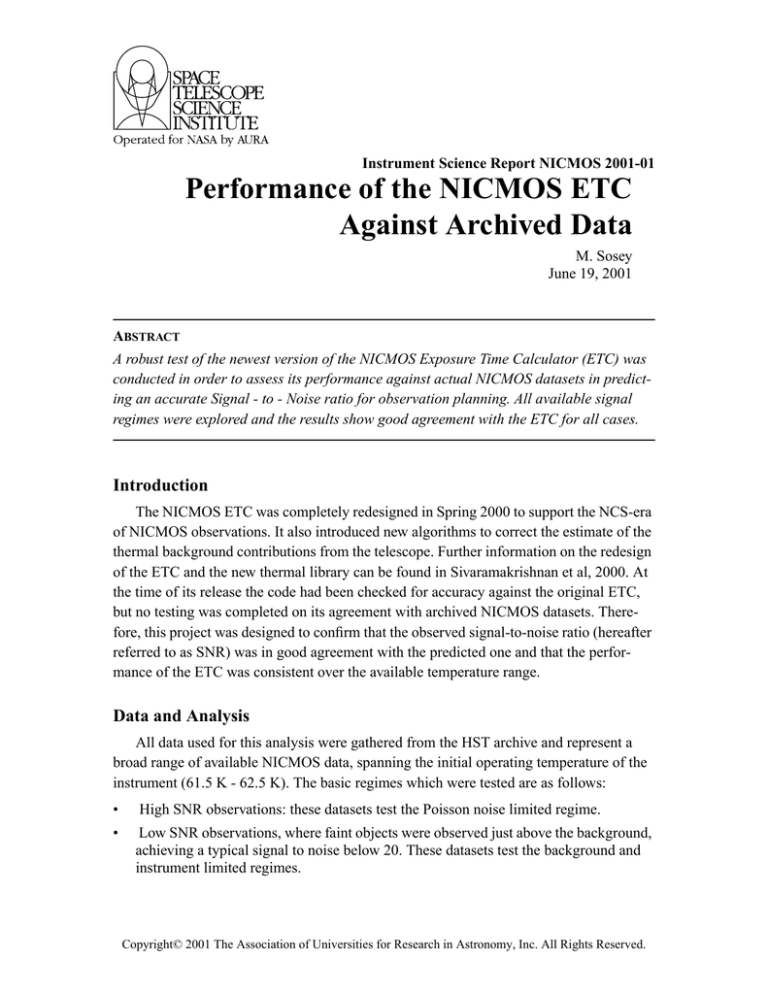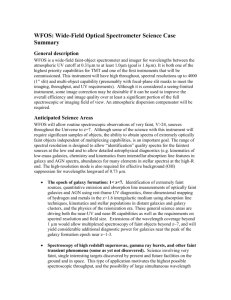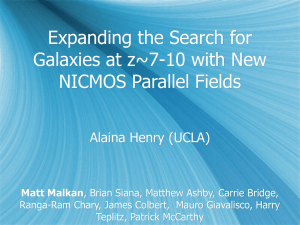Performance of the NICMOS ETC Against Archived Data
advertisement

Instrument Science Report NICMOS 2001-01 Performance of the NICMOS ETC Against Archived Data M. Sosey June 19, 2001 ABSTRACT A robust test of the newest version of the NICMOS Exposure Time Calculator (ETC) was conducted in order to assess its performance against actual NICMOS datasets in predicting an accurate Signal - to - Noise ratio for observation planning. All available signal regimes were explored and the results show good agreement with the ETC for all cases. Introduction The NICMOS ETC was completely redesigned in Spring 2000 to support the NCS-era of NICMOS observations. It also introduced new algorithms to correct the estimate of the thermal background contributions from the telescope. Further information on the redesign of the ETC and the new thermal library can be found in Sivaramakrishnan et al, 2000. At the time of its release the code had been checked for accuracy against the original ETC, but no testing was completed on its agreement with archived NICMOS datasets. Therefore, this project was designed to confirm that the observed signal-to-noise ratio (hereafter referred to as SNR) was in good agreement with the predicted one and that the performance of the ETC was consistent over the available temperature range. Data and Analysis All data used for this analysis were gathered from the HST archive and represent a broad range of available NICMOS data, spanning the initial operating temperature of the instrument (61.5 K - 62.5 K). The basic regimes which were tested are as follows: • High SNR observations: these datasets test the Poisson noise limited regime. • Low SNR observations, where faint objects were observed just above the background, achieving a typical signal to noise below 20. These datasets test the background and instrument limited regimes. Copyright© 2001 The Association of Universities for Research in Astronomy, Inc. All Rights Reserved. Instrument Science Report NICMOS 2001-01 The above scenarios were tested for point sources and extended objects in each of the NICMOS cameras, and when available, in several different filters. Unfortunately data about known faint stars was unavailable in the database, therefore no testing was done in this part of the PSF regime. The SNR for each image was calculated as: St SNR = ---------------------------2 St + ( σt ) where: S is the total signal for the source in electrons / pixel / second σ is the rms noise in the background in electrons / pixel / second t is the total exposure time for the observation Each dataset was evaluated separately and the respective properties for each object were entered into the ETC web form to calculate the predicted SNR. Point Sources The ETC returns only the SNR for the central pixel of the observed PSF. To achieve this, the total flux value calculated by SYNPHOT is multiplied by the pixfrac - the fraction of total energy that falls on the central pixel of the PSF. This assumes that the image is centered on that pixel. In practice, it’s possible to measure the signal in the peak pixel using the imexam routine in the IRAF package. Imexam fits a gaussian profile to the pixels surrounding the center of the star and then returns the peak value for that fit. This is preferable over using imstat to obtain the highest pixel value around the center of the star because of individual pixel sensitivities and detector cosmetics. The stars were carefully selected to avoid known bad pixels and grot (Sosey et al, 1999). No preference was given to any quadrant in any of the cameras, object locations were spread across the entire array. Each selected dataset was fully processed through the NICMOS pipeline and associated algorithms when necessary (such as pedsky), using the most current reference files, which in some cases included synthetic darks and flatfields (to account for changes in detector temperature). Care was taken in images affected by many cosmic ray hits and other anomalies to get a realistic measurement of the background noise. No extinction values were calculated for any of the point sources. The NICMOS standard stars were chosen for testing bright, high SNR PSFs. The requisite Kurucz spectra was chosen for the solar analogs, and a black body spectrum at the appropriate temperature was used to simulate the White Dwarf. The Kurucz spectra are stored in the CDBS archive and cover the wavelength range from 1000Å - 10 microns. They are specified by effective temperature, metalicity and gravity and called through the SYNPHOT routine icat which then interpolates between the spectra in the database which bracket the specified values. Table 1 lists information about each of the standard stars. 2 Instrument Science Report NICMOS 2001-01 Table 2 details which stellar datasets were chosen and their resulting measured and predicted SNR values. Table 1. Information for each of the NICMOS standard stars used Star Name Type Mag Other Info. P330E Solar Analog 12.01 (J) G2V-Kurucz G191-B2B White Dwarf 12.6 (J) Teff ~ 61300 P177D Solar Analog 12.47 (J) G2V-Kurucz Location of the object on the detector is not a provided option, as the ETC does not attempt to model flat field variance, it merely uses the average DQE at the pivot wavelength of the source. Since some of the standard star observations were well dithered they also provided a decent check on how much the variation in pixel sensitivity affects the SNR. Figure 1 shows the ratio of predicted and measured SNR measurements vs. wavelength for P330E. The large range in the Camera 2, F110W measurements illustrates the effects of varying pixel sensitivity across the array. Data from proposal 7693, the pupil transfer function, were used for these calculations. It is emphasized again that these are measurements on the peak flux from the central pixel, not from a full aperture. Aperture photometry in NIC 2 has been proven at the 2% level (Sosey et al, in preparation). The observed spread in SNR is too large for intrapixel sensitivity to be the main culprit. Camera 2 has 75 mas pixels which critically sample the PSF at all wavelengths. The same spread can be seen in cameras 1 and 3 to a similar extent. Figure 2 shows the ratio of predicted and measured SNR for camera 3, P177D, for the F110W and F222M filters. In the case of Camera 3 observations intrapixel sensitivity plays a larger role since the PSF is undersampled at all wavelengths, with flux variations of up to 30% for individual images of a single star observation. For more information on intrapixel sensitivity see Storrs et al, 1999. The average measured SNR for all the stellar datasets taken in a particular camera and filter combination was used for comparison against the ETC and match the predicted values from the ETC extremely well (See Table 2). 3 Instrument Science Report NICMOS 2001-01 Figure 1: SNR measurements for P330E in all cameras Figure 2: SNR Measurements for P177D in camera 3 4 Instrument Science Report NICMOS 2001-01 Table 2. Results for each of the stellar datasets which were examined Proposal ID Camera Filter Object Name Exptime (s) Predicted SNR Measured SNR % Different 7904 1 F110W G191-B2B 4.53 150 154 3 7904 1 F160W G191-B2B 9.97 100 106 6 7904 2 F110W G191-B2B 4.53 270 277 3 7904 2 F222M G191-B2B 47.96 150 138 8 7607 1 F110W P177D 3.25 120 120 0 7607 1 F160W P177D 3.25 88 77 12 7607 1 F110W P330E 3.25 150 151 <1 7607 2 F110W P177D 1.62 150 150 0 7607 2 F160W P177D 1.62 110 103 6 7607 2 F207M P330E 31.69 240 233 3 7902 1 F095N P330E 159.16 130 127 2 7902 1 F145M P330E 8.97 150 120 20 7693 1 F160W P330E 3.02 86 86 0 7693 2 F222M P330E 9.97 120 119 <1 7693 2 F110W P330E 2.42 230 244 6 7693 3 F222M P177D 7.97 180 177 2 7693 3 F110W P177D 2.12 220 233 6 7696 3 F110W G191-B2B 5.98 410 396 3 7696 3 F150W G191-B2B 7.97 439 450 2 7816 3 F222M G191-B2B 47.96 290 276 5 7816 3 F110W P177D 4.98 350 334 5 7816 3 F160W P177D 5.98 360 345 4 7816 3 F215N P177D 63.96 200 172 14 7816 3 F240M P177D 13.95 260 240 8 7152 3 F110W P330E 1.64 250 132 47 7152 3 F166N P330E 31.97 190 146 23 7152 3 F222M P330E 1.64 100 86 14 The largest disagreement between the SNR values predicted by the ETC and those measured from the data can be found in camera 3. The measurement of P330E in the F110W filter only agreed to 47%. Other images of P177D and G191B2B in the same filter agreed quite well with the ETC estimates. Closer examination of the P330E image itself 5 Instrument Science Report NICMOS 2001-01 reveals it to be about twice as noisy as the others (See Figure 3). This dataset was taken 30 minutes after a 23 minute long SAA (South Atlantic Anomaly) passage. Other images which executed in the same proposal (7152) also show increased noise that improves as the image start time is increasingly farther from the SAA exit time. This is a good example of how cosmic ray persistence can have adverse affects on the SNR of NICMOS observations. For more information on NICMOS and the SAA see Najita, et al. 1998. Figure 3: NIC3 comparison of P177d and P330e images at the same stretch P330E P177D Extended Sources For extended sources, the ETC returns the SNR for a pixel which is fully illuminated by the observed source. It accepts information about the source as either the surface flux from the galaxy in Jy per arcsec2 and the central wavelength, or the magnitude in Vega mags per arcsec2. Only elliptical galaxies were chosen from the database since they have the most well defined source spectrum (SED) in the ETC (the elliptical galaxy spectrum was provided by M. Rieke and is unpublished). Each of the datasets were processed through the NICMOS calibration pipeline and associated routines when necessary (such as pedsky). The surface flux from each object was measured in a circular radius and an estimate for the background noise was calculated through the IRAF routine iterstat. Incomplete color information about each of the sources makes it hard to calculate a reasonable extinction, therefore, none was used to correct the elliptical SED. 6 Instrument Science Report NICMOS 2001-01 Table 3 is an example dataset of extended object measurements. The data is taken from proposal 7895, a snapshot survey of field galaxies. Both objects were compact and each was measured using an aperture of 6 pixels. Even in this faint SNR regime, the ETC does a fairly good job of predicting the actual SNR for both the individual datasets and the average combined measurements. The compiled results for each of the chosen extragalactic datasets can be found in Table 4. Table 3. A closer look at proposal 7895, all data are from Camera 2, F160W Object Name Gal-141748+523117 Gal-141729+522738 Surface Brightness Jy arcsec-2 Measured SNR ETC SNR 6.7e-5 9.24 9.7 6.7e-5 9.28 9.7 6.8e-5 9.42 9.8 9.7e-5 12.08 13 9.7e-5 12.58 13 8.2e-5 11.12 12 7 Average Measured SN Avg. Surface Brightness Jy arcsec-2 ETC results using average 9.31 6.73e-5 9.7 11.93 9.2e-5 13 Instrument Science Report NICMOS 2001-01 Table 4. Results for each of the galaxy datasets that were chosen Prop ID Cam Filter Object Type Object Name Exptime (sec) Predicted SN Meas. SN % different 7875 1 F160W Faint Blue Compact Galaxies SA68-9640 2816 8.8 6.7 23 7875 1 F160W Faint Blue Compact Galaxies SA68-8846 2816 8.9 6.7 23 7875 1 F160W Faint Blue Compact Galaxies SA68-17418 2816 8.8 6.5 26 7875 1 F160W Faint Blue Compact Galaxies SA57-1501 2816 3.9 2.8 28 7875 1 F160W Faint Blue Compact Galaxies HER1-13925 1280 19 16 28 7875 2 F160W Faint Blue Compact Galaxies SA68-1067 1344 38 33 26 7875 2 F160W Faint Blue Compact Galaxies SA68-3307 1280 20 16.5 28 7875 2 F160W Faint Blue Compact Galaxies SA68-6597 1344 7.7 6.7 13 7454 2 F160W Faint Radio Galaxies 3c184 514 5.5 6.4 14 7454 2 F160W Faint Radio Galaxies 3c184 1026 11 10.74 2 7454 2 F160W Faint Radio Galaxies 3c184 1026 9.3 9.48 2 7454 2 F160W Faint Radio Galaxies 3c184 514 6 6.25 2 7454 2 F160W Faint Radio Galaxies 3c184 1026 11 7.46 32 7454 2 F165M Faint Radio Galaxies 3c266 1026 2.0 2.33 14 7454 2 F165M Faint Radio Galaxies 3c266 514 0.77 0.93 17 7454 2 F165M Faint Radio Galaxies 3c266 1026 2.0 2.66 24 7454 2 F165M Faint Radio Galaxies 3c266 1026 1.6 1.23 23 7280 2 F110W Faint Galaxies 53W069 514 1.1 0.59 46 7280 2 F110W Faint Galaxies 53W069 514 1.4 0.92 34 7280 2 F110W Faint Galaxies 53W091 514 1.4 0.67 52 7328 1 F160W Bright Seyfert Galaxy IRAS 1832-5926 256 280 270 4 8 Instrument Science Report NICMOS 2001-01 Prop ID Cam Filter Object Type Object Name Exptime (sec) Predicted SN Meas. SN % different 7328 2 F160W Bright Seyfert Galaxy IRAS 1833-654 256 170 121 28 7328 2 F160W Bright Seyfert Galaxy IRAS2302-0004 256 180 140 22 7425 3 F160W Faint Galaxy Cluster 0026+1653 576 10 8 20 7425 3 F160W Faint Galaxy Cluster 0026+1653 576 16 14 12 7425 3 F160W Faint Galaxy Cluster 0026+1653 576 13 11 15 7425 3 F160W Bright Galaxy Cluster 0026+1653 576 41 36 12 7425 3 F160W Bright Galaxy Cluster 0026+1653 576 29 22 24 7459 3 F110W Faint Galaxy Cluster 171411+501550 272 9 11 18 7459 3 F110W Faint Galaxy Cluster 171411+501550 272 10 12 16 7459 3 F160W Faint Galaxy Cluster 171411+501550 272 19 17 10 7459 3 F160W Faint Galaxy Cluster 171411+501550 272 20 18 10 7459 3 F110W Faint Galaxy Cluster 171411+501550 272 19 22 14 7459 3 F160W Faint Galaxy Cluster 171411+501550 272 36 33 8 7817 3 F110W Bright Galaxy HDF NIC Field 1344 25 26 4 7817 3 F110W Bright Galaxy HDF NIC Field 1408 26 27 4 7817 3 F160W Bright Galaxy HDF NIC Field 1408 94 89 5 7817 3 F160W Bright Galaxy HDF NIC Field 1408 43 40 7 7817 3 F110W Faint Galaxy HDF NIC Field 1408 18 19 5 7817 3 F160W Bright Galaxy HDF NIC Field 1408 62 58 6 7817 3 F110W Bright Galaxy HDF NIC Field 1408 120 125 4 7817 3 F110W Faint Galaxy HDF NIC Field 1408 19 18 5 7458 1 F110M Bright Galaxy NGC 1339 256 70 59 16 7458 1 F110M Bright Galaxy NGC 1339 256 68 57 16 7458 1 F110M Bright Galaxy NGC 1339 256 66 58 12 9 Instrument Science Report NICMOS 2001-01 Conclusions and Changes to the ETC Web Interface As a general estimate of exposure time, the ETC predicts a very accurate SNR for bright point sources. Except for some of the medium and narrow band filters, all of the SNR predictions were within 10% of the measured values. Even for the case of varying sensitivity across the detector, the average SNR of the measurements was well estimated. The results from proposal 7693 show that the local SNR can vary by a large amount, so users should avoid the lowest DQE areas when possible. Although no faint stellar sources were tested, the results from this report suggest that the ETC would also do a good job in predicting accurate SNR’s for faint stellar sources. In general, the ETC did a good job of predicting SNR for both faint and bright extended objects. The predicted and measured values are generally within 20% of each other and in some cases better than 10%. Low SNR observations can suffer greatly from background noise induced by thermal emission from the telescope optics (affecting the longer wavelength filters) and the typical noise characteristics of the detectors. In these cases it is hard to accurately predict the final observation characteristics. The results from the faint galaxy measurements of proposal 7280 show how difficult it is to predict and measure SNRs around 1. They also show that the ETC did a fairly good job of calculating an accurate SNR. Note that the large percentage difference between the predicted SNR and measured SNR is a result of the small numbers that are involved. The ETC also appeared to report slightly better SNR values for the faint blue galaxies that were measured in F160W. Users observing such objects may wish to slightly overestimate their exposure times in order to get the desired SNR. The following items in the operation of the NICMOS ETC graphical user interface have been changed: • Under the HST standard star spectra that are listed, only the standard stars that have somewhat well defined infrared spectra in CDBS (i.e. are populated past 0.9 microns by more than a few points) were saved. All other spectra have been removed from the options box. However, it should be noted that only the NICMOS standard stars (P330E and G191B2B) have spectra which have been obtained using both ground and space based data as reference. Other spectra contain only general extrapolations into the infrared from the visible. • The “Real Object” templates should include a text description of their spectral classification in the option box, for easy reference. They cannot be extended to include this because it would interfere with the scripting of the ETC. This information may be found in Appendix A3 of NICMOS-ISR-00-0001 and there is already a link in the ETC GUI directly to that ISR on the NICMOS website. • The option to use Grism filters for NIC3 has been removed since they are not supported by the ETC. 10 Instrument Science Report NICMOS 2001-01 • New aperture corrections were computed as part of work being done to improve the NICMOS photometric calibration. The old values have been updated to agree with the new aperture corrections (results of the improved photometric calibration will be presented in a future ISR). The current ETC contains a subset of apertures corrections and filters that do not represent each filter and camera combination. It has a table of values which are interpolated to find the aperture correction for a given filter. While this correction is fairly linear with wavelength for all cameras, the ETC would be easier to maintain if a full table of filter and aperture corrections replaced this old table of values. • The option to have more than 1 number of reads (nread) has been removed. The default value is now 1 and no longer a user option. NICMOS users in cycle 11 and beyond should expect to use this version of the ETC to aid in calculating exposure times for their programs. The datasets tested for this analysis spanned the entire range of available temperatures. After NCS is installed NICMOS is expected to operate at the higher temperature of 78K, this is now the default temperature in the ETC web interface. The increased temperature will decrease the large range of DQE values that were seen during the initial lifetime of the instrument. Users should still avoid the low DQE regions when designing their observations, but the difference between the lowest and highest DQE regions will be smaller. Work is in progress to integrate all of the HST instrument exposure time calculators into a more uniform, observatory wide ETC as part of the Astronomy Proposal Tools package, but the basic functionality of the ETC should not change. References Burstein, D., Heiles, C., ApJ, 225:40-55, 1978 Calzetti, D., Kinney, A., Storchi-Bergmann, ApJ, 429:582, 1994 Rieke, G. H., Lebofsky, M. J., ApJ, 288:618-621, 1985 Najita, J., Dickinson, M., Holfeltz, S., NICMOS ISR-98-001, 1998 Seaton, M. J., MNRAS, 187, p.75, 1979 Sivaramakrishnan, A., Holfeltz, S., Sosey, M., Simon, B., Robberto, M. NICMOS ISR-00-0001, May 2000 Sosey, M., Bergeron, L. E., NICMOS ISR-99-008, 1999 Storrs, A.,R. Hook, M. Stiavelli, C. Hanley, W. Freudling NICMOS ISR-99-005, 1999 Zombeck, M. V. 1990, Handbook of Astronomy and Astrophysics, Second Edition: Cambridge University Press) 11 Instrument Science Report NICMOS 2001-01 12








